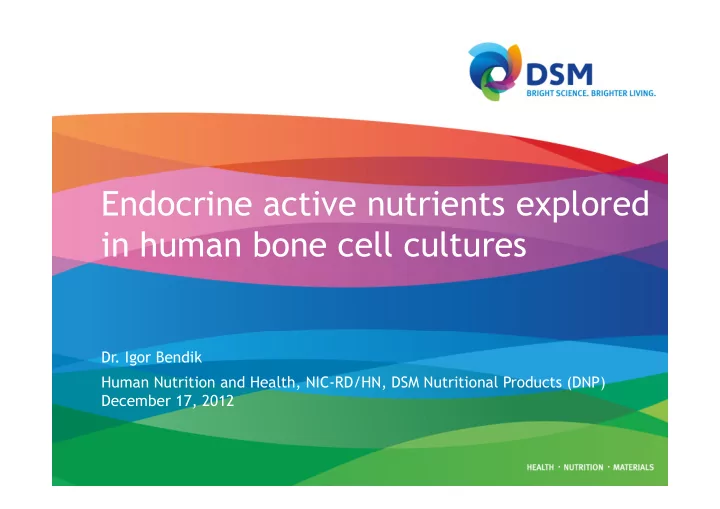

Endocrine active nutrients explored in human bone cell cultures Dr. Igor Bendik Human Nutrition and Health, NIC-RD/HN, DSM Nutritional Products (DNP) December 17, 2012
Overview DSM Family – DSM Nutritional Products Endocrine active substances – in Nutrition Bone Cell Culture Models Endocrine Disruptor Consideration Conclusion Page 1
DSMs global presence 2011 World total: 200+ locations, 22,000 employees North America: China: 33 locations 31 locations 4,000 employees 3,000 employees Europe: 64 locations 13,000 employees India: 8 locations 700 employees Latin America: 15 locations 1,000 employees Page 2 Page
DSM Nutrition at a glance 2011 • Net sales € 3,370m • EBITDA € 735m • EBITDA margin 21.8% • R&D € 200m • Workforce 8,329 Page 3 Page
Endocrine active substances in nutrition In Foods or supplements • Vitamins • Carotenoids • Nutraceuticals Page 4
Nutraceuticals vs Endocrine disruptors Nutraceutical Endocrine disruptor • Natural substances from foods • Exogenous substances altering that provide physiological function(s) of the endocrine health benefits or provide system to cause adverse health protection against chronic effects in an intact organism, or diseases its progeny, or (sub)populations • Nutritional origin • Non-nutritional origin • Molecular effects supportive • Molecular effects disruptive Page 5
Animal welfare – Ethical commitments Reduction of the number of animals tested Refinement of the methodology Replacement of the animal model RRR Page 6
Example: Bone biology Endocrine active substances (EASs) • Bone remodeling is a balanced coupling of bone formation and resorption • Two different cell types play a role: Osteoblasts and Osteoclasts Source: http://www.bonekey-ibms.org/ Page 7
Human primary bone cultures In vitro bone models (osteoblasts) 1. Mesenchymal Stem Cells (BMSC) isolated from bone marrow, differentiation through Osteostimulation 2. Primary Osteoblast Cells (pOB) collagenase-digest of human trabecular bone 3. Primary Periost Cells collagenase-digest of periostal layer Page 8
Human primary bone culture Primary osteoblasts pOB cell culture model For reproducible results Characterize pOB batch using • gene expression fingerprint (profiling) Perform analysis with 4-6 • passages after the harvest of the primary cell culture Page 9
pOB Affymetrix GeneChip Array Analysis Page 10
Functional expression analysis in primary human osteoblasts Genistein and the endogenous hormone 17beta- estradiol have identical gene regulation pattern on selected bone marker genes Page 11
DNP Strategy on nutraceutical safety Toxicology and ADME • Literature assessment • In silico assessment – Toxicitiy alerts (DEREK Software) – Metabolism (METEOR Software) • Screens – Genotoxicity ( in vitro micronucleus test) – Additional investigations as necessary (e.g nuclear receptor test battery) • Regulatory safety package Page 12
Non-mandatory DNP screening battery for endocrine disruptors Case-by-case decision depending on: I. Structural alert II. Systemic exposure III. Results of available in vivo toxicological information IV. Regulatory environment V. Customer expectation • In vitro (with parent and possibly metabolites) – ER transactivation assay – AR transactivation assay – Steroidogenesis assay – Aromatase assay • In vivo – uterotropic and Hershberger assay (if positive in vitro ) Page 13
Conclusions Primary bone cell cultures • Different human primary bone cell culture models available for bone biology (for efficacy testing) • Certain vitamins, nutraceuticals function through nuclear receptors also in bone tissue (along the endocrine axis) • Limitation of primary cell culture model for biological questions: – No systemic approach – Knowledge on pathways important – Comparative analysis using controls only: targeted approach Safety assessment of endocrine disruption (ED) in bone cells • ED analysis using primary bone cells requests mechanistic knowledge on detrimental homeostasis disruption – Whole transcriptome analysis possible (Affymetrix or Illumina), but will require validation • DNP Safety evaluation approach, OECD recommendation Page 14
Thank you for your attention igor.bendik@dsm.com Page 15
Recommend
More recommend